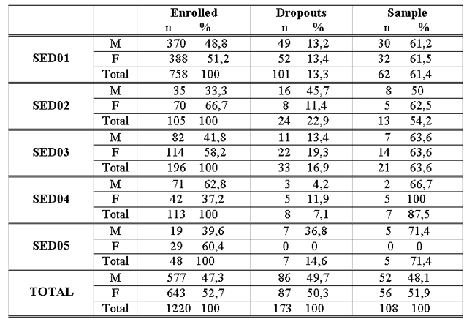
This study traces the root causes of dropout rates in one post-graduate course “Studies in Education,” offered by the Hellenic Open University (HOU). From our research findings, it was found that the main cause of dropping out stem from a combination of adult learners’ obligations, specifically balancing their academic workload with their employment commitments and family obligations (mainly for female students). The second reason for dropout rates among adult distance education learners include students’ miscalculation of the available time for studying and their underestimation of the extra effort required for effective learning. These reasons can be compared to the educational material, which, in general, was not considered overly difficult and did not appear to compel students to abandon their studies.
Keywords: dropout; distance education; adults education
The establishment of open universities around the world aims to address the educational and re-educational needs of workforce labor needs by providing quality, high level studies (Evans and Lockwood, 1994; Evans and Nation, 1996). Open Universities develop educational activities based on an educational philosophy that is different from the conventional educational systems. The main aspect of this open learning philosophy is to promote life long education and to provide adults with “a second educational chance” (Keegan, 1993).
The method used known as distance learning studies addresses the educational needs of citizens and increases the educational benefits within the geographical dominion of a country or even outside its borders, thereby by-passing geographic, social, economic and time obstacles. With this method educational policies that promote educational equality are supported. Open universities can provide university level education to citizens who, owing to prohibitive reasons – such as not being able to physically be present at a specific place – would otherwise prevent them from studying (Garrison, 1993; Davies, 1997). In other words, access to open learning offers sensitive population groups (e.g., unemployed, handicapped, mothers, emigrants, immigrants, etc.) the opportunity to further themselves through attaining a quality education.
Taking the above into consideration, this article focuses on the establishment of the Hellenic Open University (HOU), the origins of which can be traced back to 1992. In 1995, an administrative committee was established to help determine and manage the orientation of this nascent institution. In 1997, its founding law was passed. Looking at the records of the administrative committee of for 1995-1997, a period of time in which the overall characteristics of the institution were defined and formed, it was evident that the British model significantly influenced the subsequent formation and operation of the Hellenic Open University. Furthermore, after an interdisciplinary agreement was ratified allowing the Hellenic Open University to use such learning materials, many materials developed for distance learning in English universities (i.e., Manchester and the Open University), were translated into Greek.
During the period 1997-1999, a sizable portion of the Hellenic Open University’s educational material was developed and the first members of its staff were trained in this new educational methodology. From 1999 to 2000, the Hellenic Open University began to function fully, with 4,537 students enrolled in undergraduate and graduate courses. Today, student demand for distance learning studies surpasses the Hellenic Open University’s current course offerings. For 4,537 places, the Hellenic Open University received 23,941 applications (13,500 for undergraduate studies and 10,441 for post graduate studies). To admit students, a draw is usually held. Also it must be underlined that although tertiary studies in Greece are offered to students free of cost, at the Hellenic Open University charges students tuition to cover its operating costs.
The Hellenic Open University adopted the modular system, with modules of one academic year as its basic functioning unit. Educational material used primarily consists of printed material, supplemented with audio-visual material. Each tutor-advisor oversees the learning progress of about 30 students. To earn an undergraduate degree, students must successfully complete 12 modules in not less than four academic years. Note, that the term module for the Hellenic Open University means an entire course lasting one academic year. To earn a postgraduate degree, students must successfully complete four modules (not earlier than two academic years). At the post graduate level, simple modules of one academic year are provided to interested students. To complete a module, students must complete four essays totaling 30 percent of the final grade and sit for a final exam, accounting for 70 percent of the final grade. Students have the option of attending four group-counseling meetings that take place at home or at a convenient location nearby.
We conducted a survey to examine the root causes of student dropout occurring within the modules intended for teachers or teachers-to-be: Open and Distance Learning Education (SED01), Adult Education (SED02), The Child’s Development in the Social Environment (SED03), Administration of Educational Units (SED04) and Educational Research in Action (SED05). Together, these modules constitute the postgraduate course called “Studies in Education.”
Student dropout occurs at all levels of education. A rich literature concerning primary and secondary education dropout and educational underachievement reveals an area of great interest for researchers spanning many years. Research focusing specifically on the reasons of student dropout at universities can be found in Tinto, (1975) Bajtelsmit, (1988), and Giles (1999). The reasons behind the causes of this phenomenon at the Hellenic Open University is of particular importance, especially taking into consideration that distance learning is aimed to reduce educational inequality. Because these students have all enrolled in the module of their choice and paid part of their fee, it is assumed from the outset that these adult learners have selected and programmed their course of studies in accordance with their personal interests, capabilities, personal responsibilities and obligations. The study of the causes of student dropout at the Hellenic Open University can substantially contribute to the evaluation of the institution as a whole, especially for the University’s postgraduate program: “Studies in Education.”
In this study we examined the extent to which certain characteristics of postgraduate learners were related to gender. We studied the demographic and occupational characteristics of those students who chose to discontinue their studies and the reasons they gave for their decisions. It is clarified at this point, that we examined the root causes of study interruption during the module and before the final examinations.
To complete the picture of overall student participation in this particular postgraduate program, we examined the number of students who completed the four compulsory essays and the number of group-counseling sessions they attended. In particular, the research questions that we sought to answer included the following:
As tutors and course developers of the educational materials for the graduate course “Studies in Education,” we were concerned about of the causes of our students dropping out. In the 1999-2000 academic year, of f 1,220 graduate students enrolled in the program “Studies in Education,” 173 students dropped out (see Table 1). Of the 173 students who abandoned their studies, 108 (62.4 percent) participated in a structured interview. The remaining students could either not be located or refused to participate in the research survey. Our observations had led us to believe that the main reasons students cited as leading them to abandon their studies were:
Table 1. Dropout rates of students enrolled in the graduate gourse "Studies in Education" (m = male, f = female)

As we can see in Table 1, the sample included male and female students who dropped all five modules, with females to comprising the 52.7 percent of the total sample and the 50.3 percent of the total dropout rate for all students. Fifty percent of those students who dropped out from all the modules agreed to participate in a structured interview in the first semester of 2001. Student dropout rates were tabulated using the following criteria:
1. The number of essays completed before students made their decision to discontinue their studies
2. The number of group counseling sessions attended before students made their decision to discontinue their studies
In this manner, we were able to segment out and cross check the reasons why students chose to drop out, the levels of difficulty of educational materials used, and students’ actual course participation rate (as expected by the Hellenic Open University).
According to the existing legal framework in Greece, students aged 23-45 have priority for enrollment. As we can see in Table 2, students who encountered the highest dropout rates belong to the 35-39 age group (30 percent), followed by the 30-34 age group (27 percent). Fifty-seven percent of those students who chose to dropout were between the age of 30 and 39 years old.
Table 2. Student dropout rates by Age Group and by Study Module
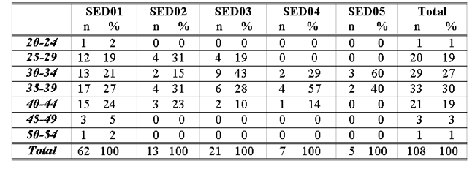
As Table 3 makes evident, all students who dropped out (with the exception of one) were employed. Only one student enrolled in module SED01 (Open and Distance Learning Education) was unemployed.
Table 3. Employment status of students who dropped out (m = male, f = female)
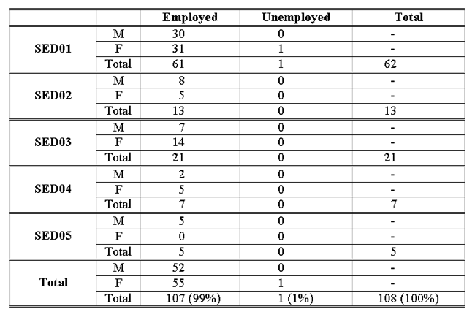
The majority of students who dropped out belonged to the 30-39 age groups, and were employed as school-teachers (see Table 4).
Table 4. Teacher and non-teacher dropout rates (m = male, f = female)
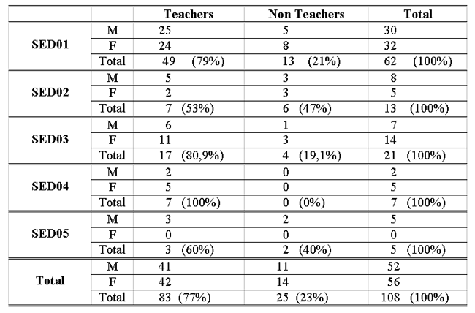
As expected, many graduate students enrolled in ‘Studies in Education’ were employed as teachers, the occupational group that manifested a higher dropout rate in all modules than non-teachers. However, our research shows that in modules SED02 (Adult Education) and SED05 (Educational Research in Action), many students who opted to dropout were not teachers.
In the SED02 module (Adult Education), which experienced high rates of student dropout (22.8 percent as compared to a mean of 14.2 percent), roughly half were not teachers. In contrast, in the SED04 module (Administration of Educational Units), in which every graduate student enrolled was employed as a teacher (see Table 4), but held the smallest percentage of student dropout (7.1 percent compared to the mean of 14.2 percent).
In terms of student characteristics, we can conclude that the majority of students who dropped from studies were between the ages 30 to 39, and almost all were employed. In terms of work history, a lower percentage of teachers dropped out of their studies than other working students. As compared to other working students, it is possible that teachers are either more familiar with studying and essay writing, or that they often have larger blocks of free time, or are more familiar with the concepts being taught.
Individuals wishing to register at the Hellenic Open University are not required to take entry exams, but instead simply complete an application form. If demand for a course is high, a draw takes place to determine who will gain entry. However, unlike conventional Greek universities, Hellenic Open University courses are cost recoverable, thus every student enrolled must pay tuition fees, a portion of which is paid in advance to secure a spot in the program of their choice. Therefore, we can safely say that the students have self-selected and programmed their studies before submitting their application and have, indeed, chosen the subject of their preference.
The most frequently reported cause students for dropping out of studies stemmed from various unexpected and emergency situations. The second most frequently reported cause for dropping out, as already mentioned, was the students’ overall underestimation of the time and effort necessary for effective studies and learning.
As we can see in Table 5, with respect to the reported reasons for student dropout, roughly half of the students (47 percent) pointed to their occupational obligations and/or workload. Dropout rates related to work commitments were reported mainly in the subjects SED02 (Adult Education) and SED01 (Open and Distance Learning Education). In terms of gender, 54 percent of male students cited workload and occupational obligations as their primary reason for dropping out, as did 46 percent of the female students.
Table 5. Reasons cited by students for dropping out
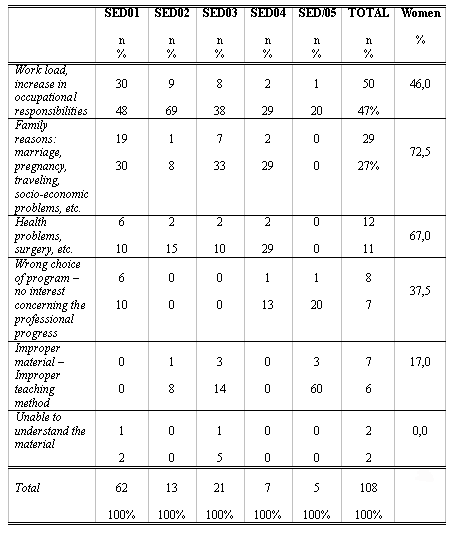
It is clear from our research that, as expected, the students’ workload and occupational demands tend to relate to students’ choosing to dropping out of their studies, and therefore do not constitute urgent attention. It is also clear that students tend to hold unrealistic views of the time necessary for effective studying and learning. Students studying at the Hellenic Open University were required to work hard work and allocate plenty of time for studying, demands that many students failed to recognize prior to enrolling.
Unexpected factors cited by students who dropped out were grouped in two categories. The first category included various “family” reasons such as marriage, divorce, and other unexpected socio-economic problems. The second group of reasons encompassed “other” unexpected factors that tend to occur in the lives of adults, which have immediate consequences in their every day routine, and thus upset their educational plans. Such reasons included death, loss of wages, or loss of employment.
Of the 27 percent of the sample who cited “family reasons” for dropping out, 27.5 percent were male and 72.5 percent female. Our finding show that students who incorrectly estimated either the amount of time that must be made available for effective studying and leaning, and/or the extent of their family obligations, also tended not to anticipate the various abrupt changes that often occur in the lives of working adults, changes that adversely affect their ability to complete their studies.
Of students enrolled in SED01 (Open and Distance Learning Education) and SED03 (The Child’s Development in the Social Environment), female students were three times more likely to drop out due to “family” reasons than male students.
Because we consider “health problems” to be independent of reasons related to “family” obligations, as well as “other” factors, we included a third category called “unexpected” events that lead students to abandon their studies. Eleven percent of the students cited poor health for abandoning their studies. In this instance, we have “unexpected events” independent from the students’ programming and their studies at the Hellenic Open University.
Of the three root causes directly connected to their studies, seven percent of students who engaged in our research mentioned erroneous course choices which proved to be of no personal or professional interest and thus led to their decision to discontinue their studies.
While six percent cited the distance method of study as their reason for dropping out, two percent of students reported that the educational material in SED03, The Child’s Development in the Social Environment, and SED05, Educational Research in Action was difficult to understand.
Table 6 indicates the stages of the courses in which students tended to give up. Some 52 percent of the students sampled failed to write any write any essays and 28 percent only completed one. In sum, occupational duties and family reasons prevented 80 percent of the students sampled from continuing their studies; they dropped out at the beginning of their course(s)before completing any essays or only one essay. This finding is in accordance with results from previous research by Holmberg (1995). Nonetheless, 16 percent of the sample chose to abandon their studies after completing two essays, while some discontinued just before the final exams, even though they had completed three or four essays.
Table 6. Number of written essays completed prior to dropping out
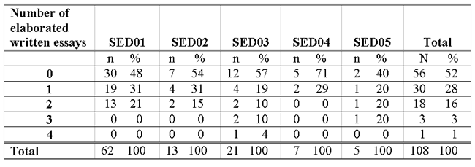
It is interesting to note that although their participation in the optional group counseling sessions for this group was higher than that of other students, 80 percent of the students sampled abandoned their studies without submitting any of the four required essays. Twenty-five percent of the students in the sample did not participate in any group counseling sessions, and 28 percent attended only one group counseling session and 53 percent of the sample attended one or no group counseling sessions, as compared to 80 percent who completed one or no essay. Thirty-one percent of the students in our sample attended two group counseling sessions, and 10 percent attended all four optional meetings, although they still ultimately decided to dropout.
Table 7. Number of Group Counseling Sessions (GCS) attended by students who dropped out by subject
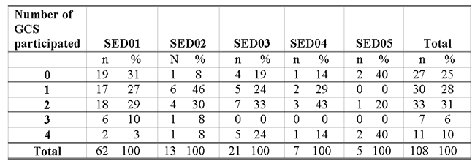
Student dropout was higher in subjects SED03 (The Child’s Development in the Social Environment) and SED05 (Educational Research in Action). It appears that essay writing is harder for some students, so much so it compels them to abandon their studies even though they appear keen and demonstrate active interest by participating in the optional group counseling sessions.
Students' evaluations of the educational material, which is the central method of distance learning used by the Hellenic Open University, are of great interest. The opinions held by students who dropped out of educational materials are of high importance to the Hellenic Open University, in that they represent those that did not successfully complete their studies due to factors unrelated to “personal” reasons. Twenty percent of the sample found the educational material difficult or extremely difficult.
Table 8. Opinions of students who dropped out of the educational material by subject
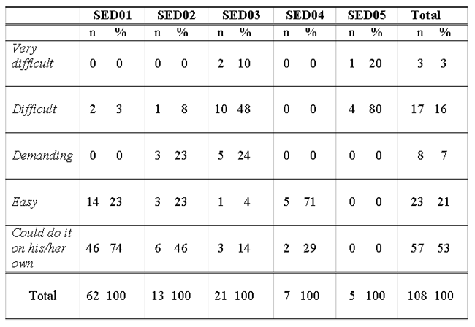
Fifty-three percent of the students sampled stated that they could study the educational material on their own, and 21 percent found it easy to understand. It is clear from our finding that the educational material did not deter the majority of enrolled students from completing their studies. It should be noted here that only two students from the sample cited the educational material as the main reason they abandoned their studies.
However, in terms of the educational material used, our research revealed areas of difficulty were concentrated almost entirely in two subjects: SED03 (The Child’s Development in the Social Environment) and SED05 (Educational Research in Action). In both subjects, the material used was not written by the Hellenic Open University faculty, but instead was an adaptation of an equivalent course offered by the Open University UK. In n terms of the number of essays completed as shown in Table 9, we can draw conclusions concerning the opinions of the sample about the educational material.
Table 9. Opinions of students who dropped out regarding the educational material by number of essays completed
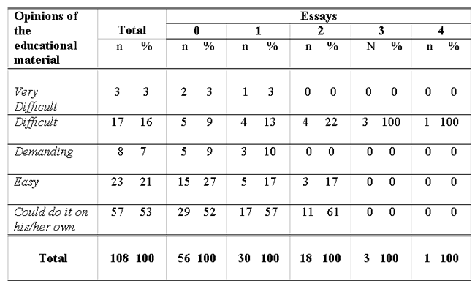
The majority of students who completed one or two essays tended to find the educational material easy to use and comprehend. This finding can be compared to the view of those students who failed to complete any essays and reveals that the complexity and difficulty of the educational materials was not a barrier to the majority of the students and thus not a factor leading them to abandon their studies.
However, a small minority of students who dropped out, and who did complete three or four essays, still found the educational material difficult. This finding reveals that there was a minority of students enrolled in subjects SED03 (The Child’s Development in the Social Environment) and SED05 (Educational Research in Action), who found the educational material difficult to grasp, subsequently compelling them to abandon their studies after having completed two, three, or even four essays, although they tried hard not to do so.
When analyzing the numbers in Table 10, we drew a similar conclusion.
Table 10. Student dropout opinion of the educational material in terms of the group counseling sessions in which they participated
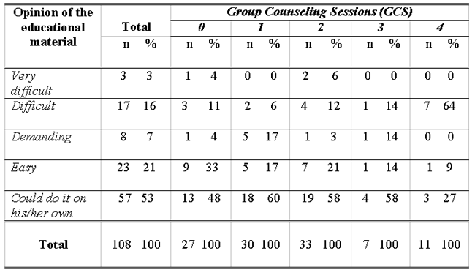
The majority of students sampled who attended one, two, or three group counseling sessions characterized the educational material used as easy to comprehend. There was, however, a small minority of students who attended every group counseling session, who still characterized the educational material as difficult to understand. It was revealed that some students who were enrolled in the subjects SED03 (Child Development in the Social Setting) and SED05 (Social Research in Action) chose to abandon their studies because they had difficulty understanding the educational material despite their participation in the expected procedures.
For the students sampled, “interest” in studies at the Hellenic Open University appears to be differentiated in relation to their intention to re-enroll in the same subject as well. Forty-nine percent of the sample intends to re-enroll in the same subject, while 34 percent answered this same question negatively; 17 percent were undecided. Note, that for re-enrollment the students must again pay tuition fees.
Table 11. Intentions of students who dropped out to re-enroll in the same subject (m = male, f = female)
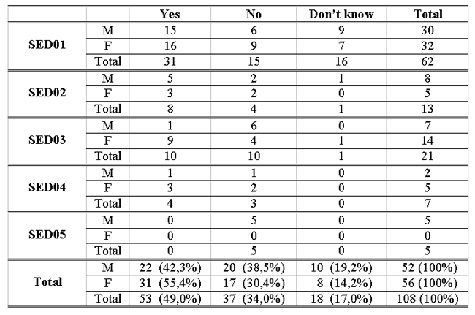
It is interesting to note that although no student from the survey sample intended to re-enroll in subject SED05 (Educational Research in Action), nearly every female student intended to re-enroll in subject SED03 (The Child’s Development in the Social Environment) as compared to almost every male student refusal to do so. From our research, it appears that gender does play a role in urging students to base their final decision as to whether or not to re-enroll in these subjects. Our research also shows that women tend to be more positive than men in terms of re-enrollment in the same subject.
The above survey leads us to the conclusion that the majority of students enrolled in the graduate course of the Hellenic Open University “Studies in Education” are between 30-39 years of age, and are presently employed as school-teachers. According to the student respondents to our survey, the main cause of dropping out stems from working adults’ obligations, specifically:
Moreover, our research reveals differences based on gender. In terms of citing family obligations leading to dropping out, female students dominate this category. The second reason cited for dropping out stems from students’ overall miscalculation of the time required for study. Fluctuations in the time available for study affected by changes in work and family environments, coupled with an underestimation of the actual effort and time necessary for studies at the Hellenic Open University, lead many students to abandon their studies. Students who opted to drop out generally failed to recognize the intensity of the subjects taught, and thus failed to devote the time necessary for study.
Slightly more than 10 percent of the students dropped out due to unpredictable factors. Difficulties associated with essay writing that contributed to dropout were mainly concentrated in two subjects (SED03, SED05). However, it is worth noting that in these same two subjects, students who discontinued their studies showed a high rate of participation in optional group counseling sessions. Only a few students reported that the educational materials were so difficult as to lead them to abandon their studies. It is important that 74 percent of the sample found the educational material easy or stated that they could manage it. A problem with the educational material appeared in those subjects SED03, SED05, which was an adaptation of an equivalent course taught at the Open University UK. Finally, despite having once again to pay required tuition fees, half of the sample expressed the intention to re-enroll at the Hellenic Open University (in the same subject).
Taking the above into consideration, we conclude that it is necessary for the Hellenic Open University to move towards the improvement of its educational material in those subjects based on translations (SED03 and SED05) and more specifically towards the writing of appropriate educational content that reflects current Greek reality. We also make it clear that a more systematic evaluation of the educational material is required. Generally, the quality of the educational material is still an important factor leading to student drop out (Wood, 1996; Galusha, 1997). Regarding informative material for prospective student candidates (e.g., the students’ handbook) it should be clearly stated that:
The decision to study at the Hellenic Open University (as is the case for any other high educational institution) assumes students engage in a systematic course of study. Studying at the Hellenic Open University requires students to allocate enough time (something adults often lack) and to keep up with the assigned schedule, both of which are vital for the continuation of studies at the Hellenic Open University.
Bajtelsmit, J. W. (1988). Predicting Distance Learning Drop-outs: Testing a conceptual model of attrition in distance study. Bryn Mawr: The American College.
Davies, C. (1977). Open Learning Systems for mature students. Dorset: Council for Educational Technology.
Evans, T., and Lockwood, F. (1994). Understanding Learners in Open and Distance Education. London: Kogan Page.
Evans, T., and Nation, D. (1996). Opening Education: Policies and Practices from Open and Distance Learning. London: Routledge.
Frase, M. (1989). Dropout Rates in the United States: 1988. Washinghton, DC.: National Center for Educational Statistics.
Galusha J. M. (1997). Barriers to Learning in Distance Education (University of Southern Mississipi, USA). Retrieved March 28, 2002 from: http://www.infrastruction.com/barriers.htm
Garrison, D. R. (1993). Quality and access in distance education: theoretical considerations. In Keegan, D. (Ed.) Theoretical Principles of Distance Education, London: Routledge.
Giles, I. M. (1999). An Examination of Persistence and Dropout in the Online Computer-Conferenced Classroom. Doctoral Dissertation. Virginia Polytechnic Institute and State University, Northern Virginia Center.
Holmberg, B. (1995). Theory and Practice of Distance Education. New York: Routledge.
Keegan, D. (1993). Theoretical Principles of Distance Education, London, Routledge.
Tinto, V. (1975). Drop-out from higher education: A Theoretical Synthesis of Recent Research. Review of Educational Research 45(1) 89 – 125.
Wood, H. (1996). Designing Study Materials for Distance Students. Charles Sturt University, Australia. Retrieved March, 28, 2002 from: http://www.csu.edu.au/division/OLI/oli-rd/occpap17/design.htm